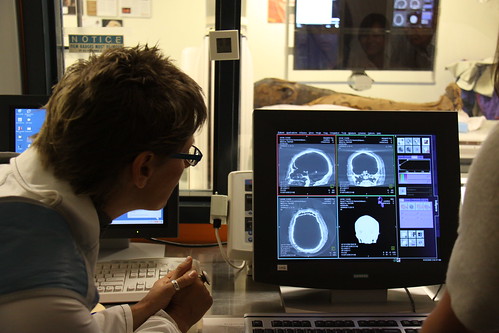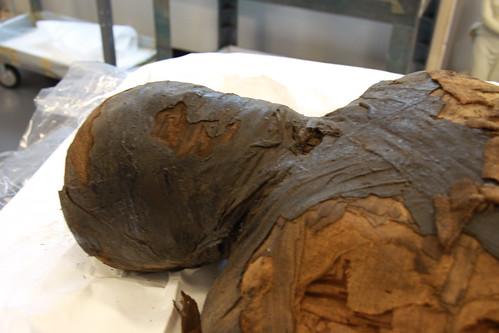
Soooo... with the advent of my internship and then subsequent job at eHuman, I have been beyond busy. I don't think they've invented a word that actually covers how much work I'm doing. Which I am not allowed to post. There's this whole 'non-disclosure' agreement companies make you sign...
In any case, I can post things that have been released into the wild, so to speak. So, here are some images I generated in OsiriX for a mummy that was recently scanned at Stanford. Some are !gasp! actually being used in print. (which I am actually incredibly giddy about...)
The Fine Arts Museums of San Francisco are putting on the Very Postmortem: Mummies and Medicine exhibit.
Here are some images from their flicker archive of the transport of the mummy."Archaeology meets technology in this small-scale exhibition exploring the scientific examination of mummies and providing new insights into the conditions under which the Egyptians lived. Included is the sarcophagus and mummy of Irethorrou, a priest from Egypt around 500 B.C. His mummy has undergone a CT-scan that allows a unique viewing experience of a three-dimensional “fly through” of the body and a forensic reconstruction of his head."
And now, to meet him internally as well.... Here is a sampling of the OsiriX images that I generated.
 A full body request - although the arms were not attached to this version of the scan. Because of the size, the mummy was scanned in multiple parts and then stitched together by the wonderful Robert at the eHuman office.
A full body request - although the arms were not attached to this version of the scan. Because of the size, the mummy was scanned in multiple parts and then stitched together by the wonderful Robert at the eHuman office. This image (without the logo and turned completely vertical) was used in the promotional flyer for the exhibit.
This image (without the logo and turned completely vertical) was used in the promotional flyer for the exhibit.



 This was another one specifically requested to show this amulet. It has been decided that it is the "Eye of Ra" and they wanted to showcase it. Unfortunately, OsiriX may not be the best program for that. No matter how much I tweaked, that was the highest level of detail that came through on the amulet in OrisiX. So I doubt they will be using this one.
This was another one specifically requested to show this amulet. It has been decided that it is the "Eye of Ra" and they wanted to showcase it. Unfortunately, OsiriX may not be the best program for that. No matter how much I tweaked, that was the highest level of detail that came through on the amulet in OrisiX. So I doubt they will be using this one.I am very excited to see the exhibit all put together, and can't wait for the 31st! (Opening it on Halloween is cute, I swear).
I will also attempt to post more often. Hopefully some other projects will become 'public friendly' and I'll be posting about other projects that eHuman is producing. It's an exciting time to be here, and I am absolutely loving my new job. And the fact that I have a job. Now this whole 'must graduate' thing is another story...



8 comments:
very nice
It is strange; I attended the event and did not see any images rendered by OrisiX build-in 3D engine; they run very beautiful movies there on huge 1080p LCD TV and printed unbelievably crisp images and none of them were rendered by native OsiriX 3D - NONE. Frankly it is very simple to verify; just go to Museum and see it; all volume rendering images/movies have High Definition Volume Rendering® signature.
Stefan - I apologize if the OsiriX images did not get included in the exhibit itself and you felt I was misleading you. I did not actually specify they were going to be in the exhibit itself in the post... However, if you look at my later posts you will see that they were included in the press release invitation and the museum member invitation. Also, the image on the website
http://www.famsf.org/legion/exhibitions/exhibition.asp?exhibitionkey=1052
was also done by me in OsiriX. I know which movies and programs you speak of and they are absolutely amazing in their own right. There may be OsiriX images added to the actual exhibit at a later date, but for now they are only being used in a promotional way. And there is no guarantee on anything being added either, just to make that clear. Again, if you felt I was falsely representing myself, I apologize. I did mention that they (the images) were being used in print, not the exhibit. And they were. Sorry for the wrong impression. I look forward to viewing the exhibit as I was not able to make it to the opening.
> I apologize if the OsiriX images did not get included in the exhibit itself and you felt I was misleading you
Apparently, there is no your fault here
I'm wandering about the origin of two images from your gallery, specifically:
1) http://3.bp.blogspot.com/_v9DbnU_DdhU/SsYi3pBcADI/AAAAAAAABcU/UyYdbRb3tAY/s400/mo15.jpg
2) http://1.bp.blogspot.com/_v9DbnU_DdhU/SsYi4EY8hKI/AAAAAAAABcc/dKKvh7_c9Wo/s400/mo16.jpg
Were these two images rendered by OsiriX native 3D VR-engine or you use HDVR plug-in for OsiriX to render them?
It would be great if you may share the presets for these two images to verify their origin.
Thanks,
Stefan
Stefan -
Yes, those images were created with the native 3D engine in OsiriX, however I used the 64-bit version, not the 32-bit. I'm not sure if that changes how the 3D renders, but I don't think it does. However, I didn't use any of the presets that come loaded with OsiriX to create those images. Rather, I used the 16bit CLUT editor to manipulate the density graph. Osiriximaging.com has a tutorial on how to use said 16bit CLUT editor, in case you have not yet seen it. Is there a specific reason you are looking to verify their origins? I could perhaps better help you if you explain a bit more. I may have the settings saved out, but I'll have to check the computer that I produced these images on.
>Is there a specific reason you are looking to verify their origins?
These images are nice and differ from what I used to see from OsiriX native VR.
Thanks for "16bit CLUT" tip; I'll investigate it.
Stefan
Thank you, and no problem! My parent website, shegmann.com, also has other images and tutorials on it. I sometimes edit my images in Photoshop or Premiere after the initial export, but this grouping was not edited. I do tweak the graphs in the 16bit CLUT quite a bit, however. I usually use multiple curves, overlapping curves, and a variety of transparent overlays to try and pull as much information out of the data as possible. Of course it helps to have access to such an excellent data-set such as the mummy!
Appreciatee you blogging this
Post a Comment